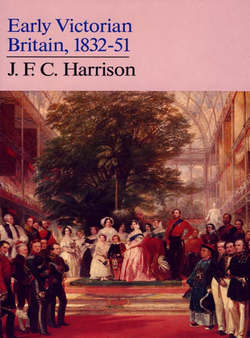Early Victorian Britain: 1832–51

Реклама. ООО «ЛитРес», ИНН: 7719571260.
Оглавление
Литагент HarperCollins USD. Early Victorian Britain: 1832–51
J. F. C. Harrison. Early Victorian Britain. 1832–51
Contents
Preface
Introduction
1 The Social Experience of Industrialism. Population: or the Fears of the Reverend Mr Malthus
The Progress of the Nation
2 Patterns of Poverty: Labouring People
3 The Condition-of-England Question
4 Patterns of Prosperity: the Middling and Upper Classes
5 Early Victorian Values. The Map of Religion: Church and Chapel
Mental and Moral Improvement
6 Social Change and Social Movements
Further Reading
General
Chapter 1
Chapters 2 and 3
Chapter 4
Chapter 5
Chapter 6
Contemporary Works
Index
About the Author. Early Victorian Britain 1832–51
Notes
Copyright
About the Publisher
Отрывок из книги
Cover
Title Page
.....
The census of 1851, as we have seen, showed that for the first time slightly more than half the population was urban. The period of fastest growth had been the decade 1821–31, but the increase was not much less during the succeeding twenty years. Most of what are now the principal cities of modern Britain continued to grow rapidly between 1831 and 1851: Manchester from 182,000 to 303,000; Leeds 123,000 to 172,000; Birmingham 144,000 to 233,000; Glasgow 202,000 to 345,000. Bradford, the fastest growing town in this period of the Industrial Revolution, had 13,000 inhabitants in 1801, 26,000 in 1821, and 104,000 by 1851. At the beginning of the century London (with nearly a million) was the only city with more than 100,000 population; by 1851 there were nine. This massive growth had come from both natural increase and immigration, the proportion differing considerably from town to town. In 1851 a half or more of the adult inhabitants of Leeds, Sheffield and Norwich had been born in the town: in Manchester, Bradford and Glasgow just over a quarter were natives; and in Liverpool the proportion was even less.
The facts of demography provided a foundation for the Victorians’ great debate about cities, but the debate focused on ‘problems’ rather than numbers. Harking back to a much older tradition of rural-urban dichotomy, in which country life was assumed to be the norm and cities an ‘unnatural’ development which required special explanation, conservative critics of the new towns concentrated their attention on what was wrong. Cobbett’s denunciation of London as ‘the great Wen’ is a picturesque and well-known example of this view. Reformers of a different stamp also joined the chorus of disapproval; and even pro-urbanites like the Reverend Robert Vaughan, who saw cities as centres of civilisation, adopted a problems approach. Vaughan’s book, The Age of Great Cities; or modern society viewed in its relation to intelligence, morals and religion (1843), was indicative of the interest in the subject from the 1840s. Preoccupation with the problems of cities, however, defined fairly rigidly the terms of the debate, and precluded any serious consideration of the process of urbanisation as such. It became almost fashionable in Victorian Britain for writers dealing with urban developments to adopt a sensational approach. Such accounts are valuable evidence of contemporary attitudes on a multitude of social situations which happened to develop in cities. They do not, as some later social historians apparently thought, tell us much about how and why the urbanisation of the population came about. As defenders of the cities in the 1840s, such as Edward Baines, editor of the Leeds Mercury, were quick to point out, many of the problems of the urban areas (sanitation, housing, education, religion) were equally prominent in the countryside. So that the problems as such cannot be used to define the nature of urbanisation. The growth of population and its concentration in cities of various sizes is the great social change to be noted here; the problems will be dealt with in succeeding chapters.
.....